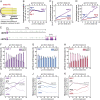Two classes of active transcription sites and their roles in developmental regulation
- PMID: 33033228
- PMCID: PMC7604424
- DOI: 10.1073/pnas.2013163117
Two classes of active transcription sites and their roles in developmental regulation
Abstract
The expression of genes encoding powerful developmental regulators is exquisitely controlled, often at multiple levels. Here, we investigate developmental expression of three conserved genes, Caenorhabditis elegans mpk-1, lag-1, and lag-3/sel-8, which encode homologs of ERK/MAPK and core components of the Notch-dependent transcription complex, respectively. We use single-molecule FISH (smFISH) and MATLAB to visualize and quantify nuclear nascent transcripts and cytoplasmic mRNAs as a function of position along the germline developmental axis. Using differentially labeled probes, one spanning an exceptionally long first intron and the other spanning exons, we identify two classes of active transcription sites (ATS). The iATS class, for "incomplete" ATS, harbors only partial nascent transcripts; the cATS class, for "complete" ATS, harbors full-length nascent transcripts. Remarkably, the frequencies of iATS and cATS are patterned along the germline axis. For example, most mpk-1 ATS are iATS in hermaphrodite germline stem cells, but most are cATS in differentiating stem cell daughters. Thus, mpk-1 ATS class frequencies switch in a graded manner as stem cell daughters begin differentiation. Importantly, the patterns of ATS class frequency are gene-, stage-, and sex-specific, and cATS frequency strongly correlates with transcriptional output. Although the molecular mechanism underlying ATS classes is not understood, their primary difference is the extent of transcriptional progression. To generate only partial nascent transcripts in iATS, progression must be slowed, paused, or aborted midway through the gene. We propose that regulation of ATS class can be a critical mode of developmental gene regulation.
Keywords: ERK/MAPK; active transcription site; germ cell development.
Copyright © 2020 the Author(s). Published by PNAS.
Conflict of interest statement
The authors declare no competing interest.
Figures






Similar articles
-
The ERK-MAPK pathway regulates longevity through SKN-1 and insulin-like signaling in Caenorhabditis elegans.J Biol Chem. 2010 Sep 24;285(39):30274-81. doi: 10.1074/jbc.M110.146274. Epub 2010 Jul 12. J Biol Chem. 2010. PMID: 20624915 Free PMC article.
-
MPK-1 ERK controls membrane organization in C. elegans oogenesis via a sex-determination module.Dev Cell. 2011 May 17;20(5):677-88. doi: 10.1016/j.devcel.2011.04.009. Dev Cell. 2011. PMID: 21571224 Free PMC article.
-
Multi-modal regulation of C. elegans hermaphrodite spermatogenesis by the GLD-1-FOG-2 complex.Dev Biol. 2019 Feb 15;446(2):193-205. doi: 10.1016/j.ydbio.2018.11.024. Epub 2018 Dec 30. Dev Biol. 2019. PMID: 30599151 Free PMC article.
-
Non-autonomous regulation of germline stem cell proliferation by somatic MPK-1/MAPK activity in C. elegans.Cell Rep. 2021 May 25;35(8):109162. doi: 10.1016/j.celrep.2021.109162. Cell Rep. 2021. PMID: 34038716 Free PMC article.
-
Signal transduction and cell fate specification during Caenorhabditis elegans vulval development.Curr Opin Genet Dev. 1994 Aug;4(4):508-16. doi: 10.1016/0959-437x(94)90065-b. Curr Opin Genet Dev. 1994. PMID: 7950317 Review.
Cited by
-
C. elegans mpk-1b long first intron enhances MPK-1B protein expression.MicroPubl Biol. 2021 Jan 14;2021:10.17912/micropub.biology.000350. doi: 10.17912/micropub.biology.000350. MicroPubl Biol. 2021. PMID: 33474533 Free PMC article. No abstract available.
References
-
- Mannervik M., Nibu Y., Zhang H., Levine M., Transcriptional coregulators in development. Science 284, 606–609 (1999). - PubMed
-
- Gubb D., Intron‐delay and the precision of expression of homoeotic gene products in Drosophila. Dev. Genet. 7, 119–131 (1986).
Publication types
MeSH terms
Substances
Grants and funding
LinkOut - more resources
Full Text Sources
Miscellaneous

